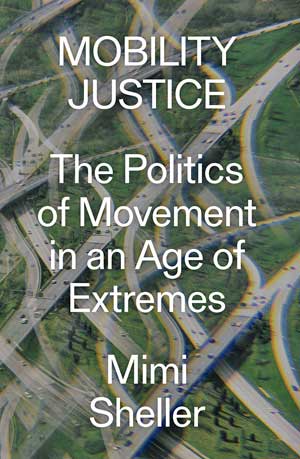
Mobility justice is one of the crucial political and ethical issues of the contemporary world. We are currently experiencing a series of crises related to how we move. As cities across the world face the effects of climate change, congestion, and pollution, and as nations struggle with debates over social inequality, immigration, and growing racism, it is increasingly evident that our old ways of moving around and of governing mobilities (and dwelling) are broken. This book contributes to generating new ways of thinking about transforming mobility to make a more sustainable and equitable world. I argue that the transition toward sustainable mobilities and greater social justice must happen together, because they are fundamentally interconnected. The societal challenge consists in democratically transitioning towards both low-carbon and socially just mobility systems, locally and globally.
What is unique about this book is that it highlights the power relations between bodies, streets, cities, nations, and the globe. Mobility justice is an overarching concept for thinking about how power and inequality shape connected patterns of mobility and immobility across many scales. It allows us to see how class, race, gender, sexuality, age, ability, and citizenship all are affected by mobility design and the systems that control and channel our mobilities. It asks: Who is able to exercise rights to mobility and who is not capable of mobility? How can sustainable transport in cities be more aware of the micro-politics of racial, gendered, (dis)abling embodiment? And how does the management of migration, tourism, and travel intersect with both everyday mobilities and with wider geo-ecological problems surrounding energy consumption and resource extraction around the world?
Mobility Justice seeks to push forward debates around sustainable cities and social movements for transport equity toward a more holistic and multi-scalar approach that I call “kinopolitics” – meaning the politics of movement. While much attention has been given to sustainable transportation in response to climate change, including by the Green New Deal currently being proposed by progressive Democrats in Congress, future mobility transitions must encompass wider mobility justice concerns. The introduction of cleaner electric vehicles, alternative fuels, bicycling lanes, complete streets, and congestion charging will promote sustainability only in a very limited sense if it is not coupled with reconfigurations of the wider power relations and cultural practices that guide urban planning and decision making.
I hope this book will help readers to think about how to transform mobility systems in deeper ways. I hope readers will find ideas about how to link together movements for environmental justice, racial justice, migrant justice, climate justice and infrastructure justice through the lens of the overarching concept of mobility justice. I hope they will be inspired to debate and discuss the principles for mobility justice that are at the end of each chapter and listed in the Appendix. I hope they will mobilize to build more just and sustainable mobile commons.
We are experiencing a triple crisis: urban crisis, climate crisis, and migration crisis. The first involves the demographic explosion, congestion, air pollution, and growing social inequality; the second, global warming and the urgent need for post-car and post-carbon transitions; and the third, the failure of current border regimes, the deaths of refugees at sea and in deserts, and the rise of racist ethnocentrism, border walls, and detention camps. Mobility Justice treats these three crises as intertwined realities demanding coherent responses grounded in the kinopolitical struggle for greater mobility justice across multiple dimensions.
This approach grew out of my work with John Urry and Kevin Hannam on the “new mobilities paradigm.” Over the past decade, we developed this new, interdisciplinary or post-disciplinary approach, which involved new theoretical and methodological innovations in both the social sciences and humanities for studying the complex movements of people, objects, and information. With the emergence of critical mobility studies, we noticed that gender, age, race, and disability are shaped by control over (im)mobilities. The least “able bodied” face major hurdles in accessing urban space and moving around, being “disabled” by built environments that prevent assisted mobility. The mobilities of some require the immobilities or coerced mobilities of others, who are often racialized, gendered, and sexualized. At the same time, the mobilities of the most privileged groups, who I call the kinetic elite, rely on the use of larger vehicles, extensive air travel, and greater energy consumption, all of which contribute to pollution, waste, and global warming that have greater impacts on the lower income regions of cities and the less developed regions around the world.
As I was finishing the book, I also became aware of existing social movements and advocacy groups such as The Untokening and People for Mobility Justice, who were developing similar ideas through a more grassroots community-based process of convening conversations. There seemed to be a growing recognition that mobility justice is one of the most important approaches for improving the lives of the Black, Indigenous, and People of Color, who are most at risk from the current mobility system. For example, low-income, minority and migrant populations in American cities experience the greatest harm, injury, and death from unjust mobility systems. They are most likely to be excluded from access to convenient and safe forms of transportation and suffer the highest rate of pedestrian deaths from motor vehicle collisions. They are exposed to greater air pollution and health impacts of climate change.
My background in Caribbean Studies led me to make these connections. I was aware of the exploitation of labor to produce plantation commodities and low-wage factory exports; the extraction of resources such as oil and bauxite (for aluminum); the environmental impacts of tourism on the region; and the coloniality of climate change that exposes Caribbean populations to devastating hurricanes and traumatic recovery processes that Naomi Klein calls “disaster capitalism.” The analytical approach of Caribbean critical theory helped me to see the wider implications for critically analyzing the colonial, racial, and patriarchal perspectives built into contemporary mobility regimes in North American cities and nation-states. We are all implicated.
If you were to encounter this book in a bookstore, I hope you would first turn to the appendix and read the “Principles of Mobility Justice.” These principles range across diverse topics and sections of the book. Some for example, refer to individual bodily movement: “Individual mobility shall not be involuntarily restricted by threats of violence, including enforced forms of clothing, segregated means of movement, or unevenly applying temporal or spatial limits on mobility.” Other principles refer to the scale of the city and transport planning: “Public investments in transport systems shall not afford mobility to some groups by imposing undue burdens, externalities, or limitations on others who do not benefit.” And some refer to the global scale: “People displaced by climate change shall have a right to resettlement in other countries, especially in those countries that contributed most to climate change.” I hope these principles might intrigue you and make you want to find out more.
I want readers to think about how these different scales are connected, and why they are all necessary for mobility justice. Maybe you would also flip through the glossary and encounter some new terms and ideas that would entice you to read the book. For example, what is a commons? “Neither state nor market, private nor public, a commons is a shared resource of a community of people with negotiated rules to sustain it and allocates its benefits, according to George Monbiot. According to Michael Hardt and Antonio Negri, the commons ‘designates an equal and open structure for access to wealth together with democratic mechanisms of decision-making. . . it is a social structure and a social technology for sharing.’”
Or, for example, what is extractivism? “Extractivism generally refers to an economic model based on the large-scale removal (or “extraction”) of natural resources for the purposes of exporting raw materials, including industrial-scale agriculture, forestry, fishing, mining and hydrocarbons. Such extractive activity, it is argued, does not benefit local economies, produces high rates of underemployment and poverty, leads to unequal wealth distribution, and leaves behind waste and pollution. Extractivism has become a significant subject of political debate, especially in Latin America, where it is contrasted with postextractivism, neoextractivism, and postcapitalism.” Here, I draw on the ideas of Arturo Escobar. One book connects to another, and readers might be led on a journey to read other works, including Anna Tsing, Donna Haraway, Keller Easterling, Deborah Cowen, and others.
I believe that a full transition in the currently dominant fossil-fuel based automobility system will only take place when we simultaneously address the issues of social inequality that underpin the un-sustainability of the current system and we begin to promote mobility justice as integral to sustainability. Spatial and cultural contexts for dwelling and moving must be redesigned to promote both sustainable mobility and mobility justice. This may mean restricting or reducing the mobilities and energy consumption of the kinetic elite. Children around the world are currently mobilizing climate marches and school strikes to get politicians to listen to them. They tell us that we need to urgently change the way our current system works. I hope this book will contribute to that movement.
In the conclusion of the book I call for “commoning mobility” or creating a “mobile commons” as a possible way forward toward more just and sustainable mobilities. I hope to develop this concept further in my next project, and I hope to find others who want to work on this. I describe commoning mobility as a verb: the enactment of cooperative social territories and shared infrastructures for moving, sharing, and conserving places. Mobile commons have been cooperatively produced by human relation to others, both human and more-than-human, through common passage, translation, and co-usage over time. Commoning mobility empowers assemblages of people-plants-animals-places to exercise generative forms of autonomous social cooperation outside of capitalism. How can we build on and sustain the mobile commons and take our world back from extractivist capitalism and the violent security state?


Mimi Sheller is Professor of Sociology and founding Director of the Center for Mobilities Research and Policy at Drexel University in Philadelphia. She is founding co-editor of the journal Mobilities, Associate Editor of the journal Transfers, and past President of the International Association for the History of Transport, Traffic, and Mobility. She helped establish the interdisciplinary field of mobilities research. She is author/co-editor of ten books, including most recently Mobility Justice: The Politics of Movement in an Age of Extremes (Verso, 2018) and Aluminum Dreams: The Making of Light Modernity (MIT Press, 2014).